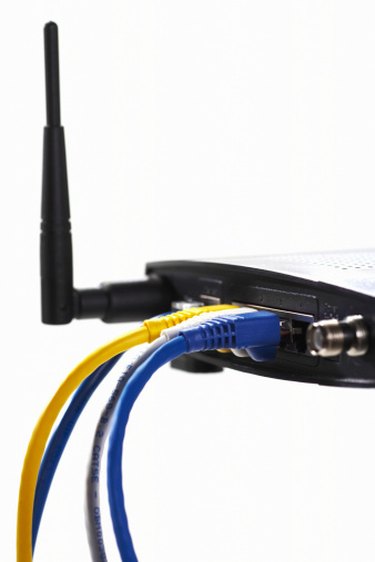
By accepting and rebroadcasting the wireless signal from a primary router, a repeater bridge allows you to effectively extend the range of your wireless network. You can turn the Linksys WRT54GS router into a repeater bridge by resetting the router, updating the firmware, setting a static IP address on your computer, changing the router settings then resetting the computer IP address. This task can be complex and time-consuming; only advanced users should try it.
Reset Router
Video of the Day
Step 1
Plug the power adapter into the secondary WRT54GS and into a wall outlet.
Video of the Day
Step 2
Press the "Reset" button on the back of the router using the tip of a sharp object such as a pen or pencil. Hold for approximately 30 seconds.
Step 3
Unplug the power adapter from the router. Continue holding the "Reset" button for approximately 30 seconds.
Step 4
Plug the power adapter back into the router. Continue holding the "Reset" button for approximately 30 seconds. Release the "Reset" button.
Update Firmware
Step 1
Open your browser and download the "DD-WRT" firmware package (see Resources). Save the file to your desktop.
Step 2
Input "192.168.1.1" into your address bar and press "Enter." The router configuration page opens in your browser.
Step 3
Click on the "Administration" tab at the top of the page then select the "Firmware Upgrade" sub-menu tab below that.
Step 4
Click the "Browse" button and navigate to the "DD-WRT" file you just downloaded to your desktop.
Step 5
Click "Upgrade." Do not interrupt the router while the new firmware installs. Wait five minutes, then reset the router again (refer to the "Reset Router" section in this article).
Set Static IP Address
Step 1
Connect the secondary WRT54GS router to the computer using an Ethernet cable.
Step 2
Click "Start" and click on "Control Panel." Double-click "Networking and Internet," then select "Network and Sharing Center." Highlight your active network connection and press "Enter." A dialog box appears.
Step 3
Click the "Properties" button. A new dialog box will appear.
Step 4
Highlight "Internet Protocol (TCP/IP)" and click "Properties." A new dialog box will appear.
Step 5
Select the option for "Use the following IP address" and enter the following values for the "IP address," "Subnet mask" and "Default gateway" respectively into these fields:
192.168.1.9 255.255.255.0 192.168.1.1
Click "OK" to save the new settings and close the dialog boxes.
Change Router Settings
Step 1
Open your browser, input "192.168.1.1" into your address bar and press "Enter." The router configuration page opens in your browser.
Step 2
Click on the "Setup" tab at the top of the page, then select the "Basic Setup" sub-menu tab below that.
Step 3
Click the "Connection Type" drop-down box and select "Disabled." Select "Disable" for the "STP" option. Select "Disable" for the "DHCP Server" option. Input "192.168.1.1" as the "Local DNS." Input the following values for the "IP Address," "Subnet Mask" and "Default gateway" fields:
192.168.1.2 255.255.255.0 192.168.1.1
Click "Save" at the bottom of the page.
Step 4
Click on the "Wireless" tab at the top of the page then select the "Basic Settings" sub-menu tab below that.
Step 5
Click the "Wireless Mode" drop-down box and select "Repeater Bridge." Click the "Wireless Network Mode" drop-down box and select the same setting as your primary router (if your primary router uses "Mixed" signals, then select "Mixed" for the secondary router as well). Enter the name of the primary wireless network into the "Wireless Network Name (SSID)" field. Click "Save" at the bottom of the page.
Step 6
Scroll down to the "Virtual Interface" section of the page and click the "Add" button. The virtual interface options appear.
Step 7
Input "Bridge" into the "Wireless Network Name (SSID)" field. Select the "Enable" option for "Wireless SSID Broadcast." Select "Disable" for "AP Isolation." Select "Bridged" for the "Network Configuration" setting. Click "Save" at the bottom of the page.
Step 8
Click the "Wireless Security" sub-menu tab at the top of the page.
Step 9
Select "WPA Personal" as the "Security Mode" setting. Enter the same values into the "WPA Algorithms," "WPA Shared Key" and "Key Renewal Interval" fields as your primary router. For example, if your primary router key renewal interval was "3600" you would enter "3600." Click "Save" at the bottom of the page.
Step 10
Click on the "Setup" tab at the top of the page, then select the "Advanced Routing" sub-menu tab below that.
Step 11
Choose "Router" for the "Operating Mode" section.
Step 12
Click on the "Security" tab at the top of the page, then select the "Firewall" sub-menu tab below that.
Step 13
Remove the check marks next to all options except the "Filter Multicast." Select "Disable" for "SPI Firewall." Click "Save" at the bottom of the page.
Step 14
Unplug the router for approximately 30 seconds, then plug it back in. The secondary router can now receive signals from the primary router as a repeater.
Step 15
Access the computer's "TCP/IP" properties again (refer to the "Set Static IP Address" section in this article) and select "Obtain an IP address automatically." Click "OK" to save the settings.